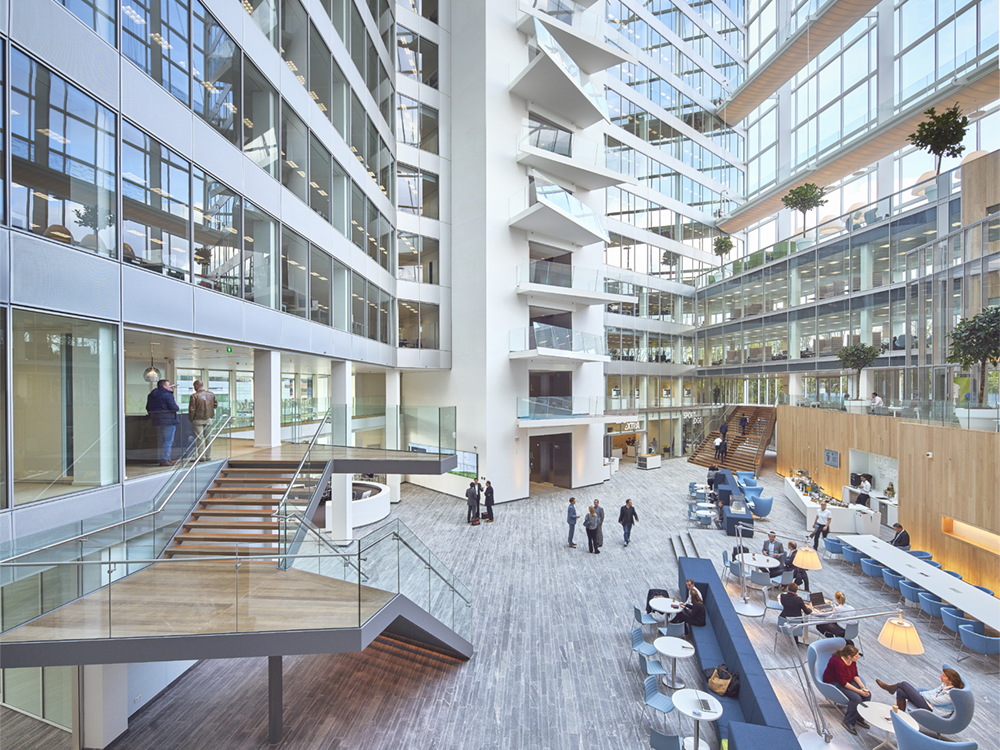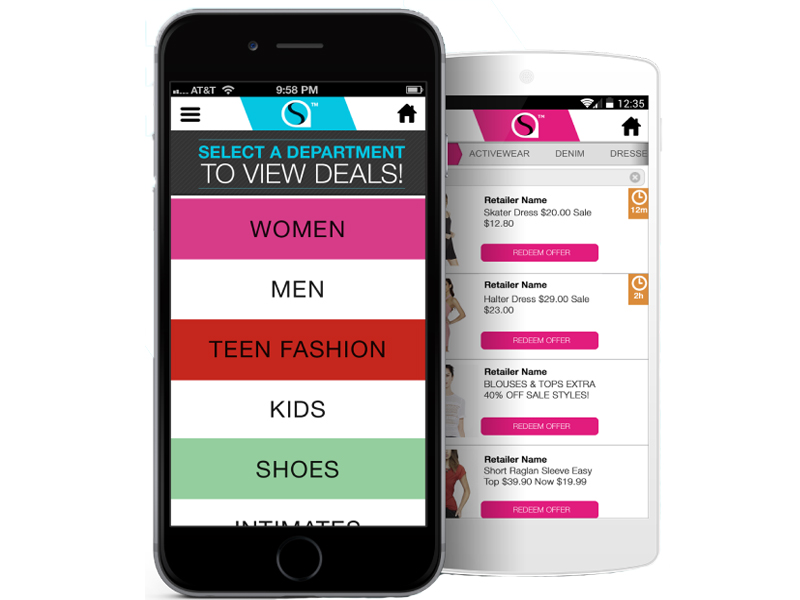Internet of Things: Digital Domination
How wider adoption is unlocking new values, creating future-ready properties.
By Samantha Goldberg

Oxford Properties’ RBC WaterPark Place III in Toronto serves as Cisco’s Canadian headquarters and is the first building in North America that runs 100 percent on the Cisco network. Image courtesy of Oxford Properties Group
“For the non-technical person, it might be difficult to imagine what an Internet-connected appliance means to the world, and specifically the commercial real estate industry.” While someone today might chuckle at this thought, given the vast number of devices now connected to the Internet, circumstances were very different in 2002, when the article containing this statement was written. Published on the website of event company Realcomm, it signifies that the idea of a more connected world was beginning to percolate even then.
In 2017, many likely take for granted how easy it is to be constantly connected, and more and more devices are becoming linked to each other every day. Leading information technology research company Gartner Inc. predicts that 20.8 billion devices will be connected by 2020, signifying our continuous path toward creating the “Internet of Things” (IoT), a truly digital world where everything can communicate with each other.
As the Realcomm article suggests, the concept of connected devices isn’t new—but it is changing. “We’ve been dealing with IoT for a long time in the real estate industry,” affirmed Jim Young, founder & CEO of Realcomm. “It was called ‘building automation,’ then ‘machine to machine,’ and now it’s called ‘IoT.’ What’s new in IoT is that devices are getting smaller, more powerful, less expensive and going to areas we never imagined.”
Constant technological advancements have propelled the concept of IoT to the forefront of discussions in many industries, including real estate, as companies increasingly see the value of adopting IoT technology. McKinsey Global Institute estimates that IoT applications could have a potential economic impact of $11.1 trillion by 2025. Clearly, the IoT is not something to ignore.
Creating Future-Ready Properties
Where IoT technology is currently making the greatest inroads in the real estate industry is in building automation and more intelligent building management, noted Dmitri Gerchikov, senior vice president of IoT and analytics at JLL Technology Solutions. Companies have been connecting devices to the Internet and using sensors in their buildings for several years, with applications such as automated lights and self-flushing toilets. By implementing IoT technology, building owners and managers can connect these sensors to the Internet and collect data on how the building’s equipment and systems are working so they know sooner when issues arise and can take effective action, explained Leif Maiorini, senior managing director and a member of Cushman & Wakefield’s Global Information Technology Leadership team. For example, a sensor could automatically detect when paper towels need refilling and send an alert rather than maintenance checking unnecessarily.
Building automation using IoT devices is also improving energy management and usage. Commercial spaces account for 20 percent of total energy consumption in advanced economies worldwide, and half of this energy is consumed in office spaces, noted a June 2015 McKinsey study. Intelligent energy management has the potential to reduce usage in offices by 20 percent, according to the study, as these systems can sense whether or not a room is occupied and adjust heating, cooling and lighting as needed.
While we’re not at the point of mass adoption, firms are increasingly able to implement IoT solutions at their properties as the technology continues to improve and reduce in cost, Gerchikov noted.
Many technology companies are developing IoT solutions and systems to make building automation and inter-device communication easier. One such firm is Cisco, which recently introduced the Digital Building Solution, which connects all of a building’s networks and services—including lighting, HVAC, metering, security and analytics—over a single IP network using the firm’s new Catalyst Digital Building Series Switch. In collaboration with several technology vendors, the Digital Building technology creates a “common language” for devices to communicate with each other and provide data to help organizations not only analyze how the building is working but how people are using it.
Similar to electrical wiring, plumbing and piping, Cisco can install an IP infrastructure as “the critical foundation of a building on top of which we can integrate lighting, sensors and analytics to deliver a cheaper and more sustainable environment than we’ve ever done before,” explained Rick Huijbregts, vice president of digital transformation and innovation at Cisco.
Cisco’s Canadian headquarters at RBC WaterPark Place is the first building in North America that runs 100 percent on the Cisco network. By building the space with an IP base, the company saved 60 cents per square foot over what a traditional building would cost, Huijbregts said. He also noted that since the firm has been in the building for a little over a year, it has started to see annual savings of almost 10 percent in operating expenses.
As companies warm up to the idea of IP-enabling and connecting their systems across multiple buildings, they start to see the potential for new and incremental value, he added.

The Edge, Deloitte’s Netherlands office, is one of the smartest office buildings worldwide, with features such as an Ethernet-powered LED lighting system, an app to find workspaces and track fitness, and a high-tech garage that identifies vehicles and points them to available parking spots. Image by Ronald Tilleman
Deloitte’s Netherlands office location, The Edge, is also among the smartest office buildings globally, as well as the most sustainable. Its features include an Ethernet-powered LED lighting system that is 80 percent more efficient than a traditional lighting system and includes about 28,000 sensors that detect motion, light, temperature and more, according to the company’s site. The firm is able to collect real-time data about how the building is running and being used. A smartphone app will assign tenants daily workspaces based on their preferences and allows them to control lighting and temperature, making for happier occupants.
Making buildings network-centric is a concept that only emerged in the last few years, Huijbregts said, adding that many companies are looking to make their proportions more connected but “it’s a long cycle in the industry from ideation to opening a door.”
Unlocking New Value
As the real estate industry begins to better connect and automate its buildings, stakeholders can not only improve how their properties run but also analyze how space is being used to improve configuration, address tenants’ needs and increase productivity.
This is really the next phase of IoT, Gerchikov said. “Everything is going to be geared toward end-user experience, and the spaces of the office that provide that experience of seamless integration and ease of use are going to attract the top talent and help the firms to manage their workforce a lot more effectively, as well as their real estate.”
More satisfied tenants also means a greater chance that they will stay put, helping building owners maintain full occupancy and avoid losing out to competitors offering a better experience. “If I’m a tenant, I’d rather go into a building that’s future-ready and gives data and insight than go into a building where I have none of those capabilities,” Huijbregts said.
He also noted that as Gen Z—those born in the mid-’90s to early 2000s, according to The Pew Research Center—enters the workforce after growing up in a digital world, companies are going to “need to rethink space and real estate.”
The ability to better understand how space is used and improve user experience makes IoT technology a valuable solution for the retail industry, as well.
“With the whole onslaught of Internet sales and the use of different types of technology by the end consumers, now retail real estate owners have an opportunity to use … information they’re gathering to provide more insight into their tenants and use these insights to create a differentiated experience,” explained Surabhi Kejriwal, real estate research leader for the Deloitte Center for Financial Services.

Major mall owners and national retailers are using the StepsAway in-mall retail solution to offer shoppers real-time promotions that they can access by connecting to the property’s guest Wi-Fi. Courtesy of StepsAway
High-end mall REIT Macerich is one retail owner adapting its centers for the IoT world. The firm this year expanded its partnership with StepsAway, an in-mall retail solution that gives shoppers access to hyperlocal in-store offers on their smartphones. Retailers create promotions using StepsAway’s cloud-based platform SAConnect™, which pushes the offers to the relevant malls. When shoppers enter those malls and connect to Wi-Fi, they can browse the current promotions by category or store.
“We think about this as a digital handout of all the promotions in the mall in the palm of your hand,” said Allan Haims, CEO of Steps-Away. Macerich will bring the solution to 22 of its properties, following a successful 2015 pilot at three of its locations. StepsAway is currently used in more than 150 malls across the country, including those from developers like GGP and Taubman.
In a world where e-commerce is growing exponentially, using these IoT solutions benefits not only retailers and customers but also mall owners. Shoppers are encouraged to spend more in-store, thereby increasing owners’ revenue per square foot and making their assets more productive, added Ken Meyer, Deloitte’s real estate services consulting leader.
Breaking the Barriers
The opportunities IoT technology affords the real estate industry are many, but there are challenges to full adoption. The first is getting the industry to accept change.
The real estate industry is “shaped by established relationships, legacy technologies and conventional practices,” Huijbregts said. “Doing something different is scary, and in an industry that is so fragmented it is easy to wait for others to be first.” However, he noted, “visionary leaders” in the industry are pushing for change, such as Oxford Properties, the developer behind Cisco’s Canadian headquarters and Hudson Yards in New York.
Another, related obstacle is ensuring companies choose the IoT system or solution that’s right for them. “We want to figure out the right questions we want to ask … and the right problems we want to solve, and then use data and IoT to solve those problems,” noted Adam Stanley, Cushman & Wakefield’s global chief information officer.
The number of IoT solutions available can be intimidating, but “as the industry matures … some of those ideas will get solidified and some will get swept aside by better solutions,” Gerchikov said.
Figuring out how to organize and analyze the vast amount of data collected will be another challenge. According to the McKinsey study, most IoT data is not currently used, and the data that is used is more for anomaly detection and control rather than “optimization and prediction, which provide the greatest value.”
“As more buildings and the ecosystem adopt more IoT and there’s this huge data avalanche, it will be more about how companies start analyzing this data and mining data to create more value for themselves and their tenants,” Kejriwal said.
Several tech startups and larger companies are beginning to develop new software offering advanced data analytics that can create more responsive environments, Huijbregts said. Having more sophisticated analytics is the necessary next step in being able to fully implement IoT technology and take advantage of the data it collects.
Aggregating data from various devices, though, raises security and privacy risks. Because IoT technology “could be perceived as quite invasive,” Gerchikov explained, “we need to be very cognizant and help our clients to navigate not only how to manage the information but also how to communicate properly to make sure employees … are fully informed.”
Companies using IoT technology will also need to make sure their networks are secure so client information and any data collected is managed properly. This requires firms to understand the complexity of IoT and the risks associated with it.
“It’s not like you just buy something and put it into your building,” Young said.
He added that it would be beneficial for every real estate company to devote a certain percent of its finances and people to looking at the innovations and best practices around the world. “You have to have a strategy. You cannot have a tactical approach to IoT.”
While these challenges may sound daunting, many will likely become easier to address as IoT technology evolves and the industry more widely adopts effective solutions.
“After salaries, for virtually every business, real estate is the largest cost of operations,” Huijbregts said. “Why not turn what once was a static building into a strategic asset to the business it houses? Digitization of all systems in buildings, and then applying advanced analytics and soon artificial intelligence, will do exactly that.”
Originally appearing in the March 2017 issue of CPE.







You must be logged in to post a comment.